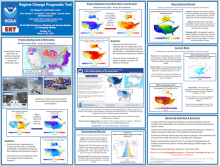Informing Major Pattern Change Messaging at the Climate Prediction Center via the Regime Change Prognostic Tool
Cory
Baggett
Climate Prediction Center
Poster
Over the last year, the United States has experienced several abrupt changes in weather regimes. For example, during December 2022, an abrupt, severe Arctic Air outbreak occurred that was quickly followed by an equally abrupt change to much above normal temperatures. The magnitude of these temperature swings were amongst the greatest experienced during winter in the last 30 years. Also during the winter of 2022-23, California experienced significant precipitation regime changes, going from dry conditions in early December to extremely wet conditions in late December and early January. A similar evolution in precipitation regimes in California also occurred from mid-February to mid-March of the same year.
These events amongst other events over the past few years have motivated researchers to understand the physical drivers that produce regime changes and their predictability at S2S timescales. Operational centers, like CPC, are interested in this research, as stakeholders often seek guidance as to when weather regimes will begin or end due to their high impact nature and visibility to the public. In fact, CPC has recently provided Key Messages to stakeholders when significant regime changes are expected.
While CPC has a large suite of teleconnection tools that are informative of the physical drivers of potential regime changes, such as blocking patterns, there is a gap in tools that objectively show the timing, location, and historical magnitude of changes in temperature, precipitation, and 500-hPa heights as forecasted by the ensemble suites of the dynamical models. This deficiency is often felt greatest at the Week 3-4 timescale, as the forecaster on duty often ponders if and when a regime change will occur during their forecast valid period. Thus, guidance that CPC provides to stakeholders on regime changes is currently sub-optimized.
The existing suite of dynamical models used for forecasting at CPC provides adequate data to potentially improve objective regime change guidance to support forecasters and improve messaging to stakeholders. Here, we develop and verify a Regime Change Prognostic Tool that explicitly identifies when and where significant regime changes in temperature, precipitation, and 500-hPa heights are forecasted to occur by the ensemble suite of dynamical models. We demonstrate the tool’s retrospective usefulness for the aforementioned cases during the winter of 2022-23.
These events amongst other events over the past few years have motivated researchers to understand the physical drivers that produce regime changes and their predictability at S2S timescales. Operational centers, like CPC, are interested in this research, as stakeholders often seek guidance as to when weather regimes will begin or end due to their high impact nature and visibility to the public. In fact, CPC has recently provided Key Messages to stakeholders when significant regime changes are expected.
While CPC has a large suite of teleconnection tools that are informative of the physical drivers of potential regime changes, such as blocking patterns, there is a gap in tools that objectively show the timing, location, and historical magnitude of changes in temperature, precipitation, and 500-hPa heights as forecasted by the ensemble suites of the dynamical models. This deficiency is often felt greatest at the Week 3-4 timescale, as the forecaster on duty often ponders if and when a regime change will occur during their forecast valid period. Thus, guidance that CPC provides to stakeholders on regime changes is currently sub-optimized.
The existing suite of dynamical models used for forecasting at CPC provides adequate data to potentially improve objective regime change guidance to support forecasters and improve messaging to stakeholders. Here, we develop and verify a Regime Change Prognostic Tool that explicitly identifies when and where significant regime changes in temperature, precipitation, and 500-hPa heights are forecasted to occur by the ensemble suite of dynamical models. We demonstrate the tool’s retrospective usefulness for the aforementioned cases during the winter of 2022-23.

Poster file
Baggett_Cory_blocking_poster.pdf
(2.57 MB)
Meeting homepage
